Why Italian Cheese Formai De Mut Tastes Different Every Time It's Made, According To An Expert
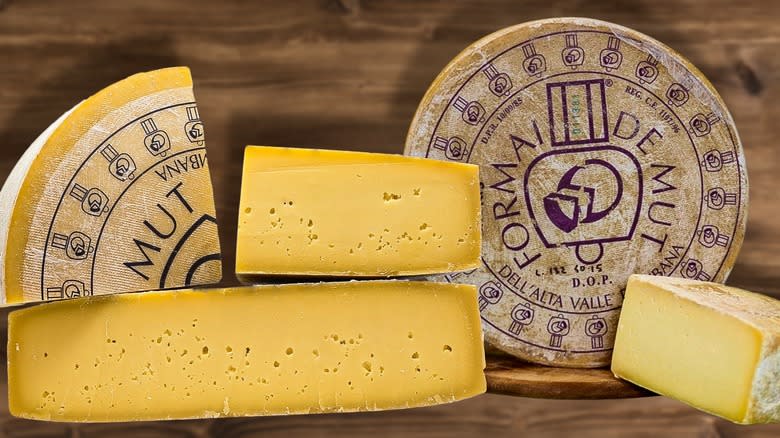
The mere mention of Italian cheese likely brings to mind familiar names like mozzarella, mascarpone, and the most popular of all Italian cheeses, parmigiana reggiano. Like all Italian cuisine, Italian cheese is deeply influenced by foods native to each area. The country's regions treasure their unique cheesemaking artistry, resulting in flavorful cheese that can instantly transport your palate to each end of the country,
Italian cheeses are beloved for their many uses in the kitchen and for their consistency of flavor. From mozzarella's mild, creamy allure to the aged sophistication of parmigiana reggiano, cheese lovers know precisely what to expect when they layer fresh mozzarella between slices of tomato for a caprese salad or stir handfuls of grated parm into creamy risotto.
If you're an adventurous cheese connoisseur looking to expand your horizons beyond the familiar, there's one Italian cheese you should look for — Formai de Mut. It's a cheese rich in flavor and history that captures the essence of the region where it's produced. "Every cheese is different, with a different personality," says Sara Cologni, a local tourist guide and ONAF Cheese Taster explained to Tasting Table. "It is a gift of nature to be discovered and enjoyed."
Read more: 44 Types Of Pasta And When You Should Be Using Them
What Is Formai De Mut?
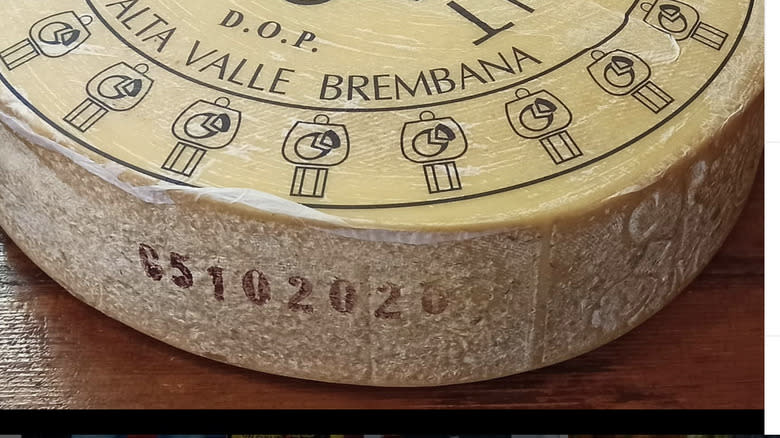
Formai de Mut is a cow's milk cheese produced in 22 municipalities of Italy's Brembana Valley in the country's Lombardy region. Loosely translated, its name means mountain cheese, the perfect moniker for cheese made from the milk of cows that graze in this mountain region. Location plays a crucial role in Formai de Mut's production and taste. The flavor of the milk is affected by the grass the cows eat, and as the cows move from the valley up the mountains, each batch has a distinctive flavor.
According to Cologni, Formai de Mut has been a key factor in the region's economy and history. "The production of cheese started to reduce during the First and Second World Wars when just a few dairymen remained to produce cheese," says Cologni. "Today, thanks to these heroic men who never abandoned the mountain, the tradition of the production of cheese has been handed down to the youngest generations who are trying to enhance the quality of these productions through specific information and expertise."
How Is Formai De Mut Made?
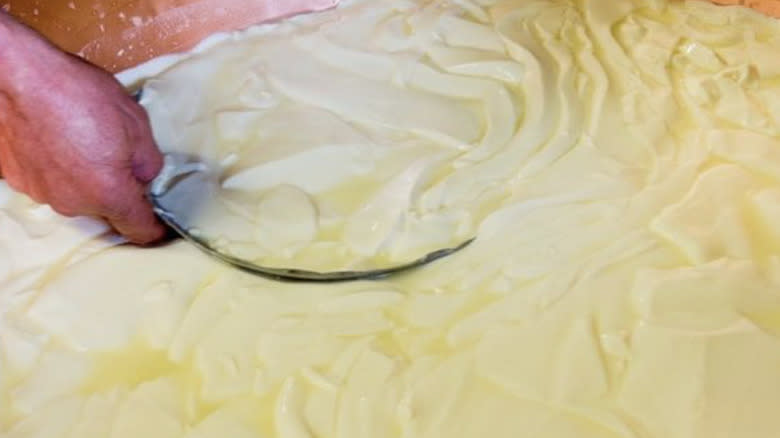
Formai de Mut was traditionally produced from May to October. According to Cologni, this is when the cows "from the valley bottom reach the high mountain pastures where they find very special fresh grass and flowers that are typical of the pre-Alpine flora." The milk is influenced by the flowers and herbs the cows find in the mountain pastures. "The biodiversity in Brembana Valley is very rich and varied," says Cologni. It wasn't until the late 1980s that the cheese was produced and available all year.
To make Formai de Mut, milk gathered from up to two milkings is mixed with rennet and warmed slightly until it curdles. Once the curd is broken, the cheese is semi-cooked. Semi-cooked cheese is heated to temperatures between 98 F and 118 F; for Formai de Mut, the curds are heated to 113 F - 117 F.
Next, "the mass is agitated and then pressed in order to stimulate the purging of the whey," says Cologni. "It is put in special filtering clothes called pate and then placed in molds known as fassere." She says the forms are then "dry-salted or salted in brine." The brining process is repeated every other day for eight to 12 days before the cheese is ripened for at least 45 days.
Varieties Of Formai De Mut
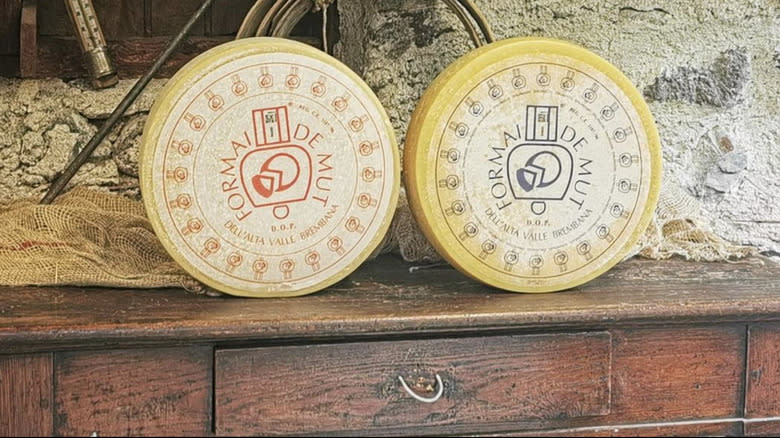
There are two varieties of Formai de Mut — d'Alpeggio and Fondovalle. D'Alpeggio is the Formai de Mut produced in the warmer months, and Fondoalle is made during the winter. Buyers can tell the difference between the two cheeses by the color of their labels. The summer version, made between May and October, has a blue label, and the Formai de Mut, made in the colder months, in late October through May, has a red label.
According to Cologni, the milk used to make blue-label Formai de Mut when the cows are at a higher altitude is "processed directly in the mountain huts called Casere and temporarily stocked in cold grottoes." This follows an age-old method of using stations that are outfitted with the equipment the shepherds need to process the milk onsite. As the cows arrive at the stations they're milked and then head back down to the valley.
"Since 1988, following the same milk processing specifics used when the animals are on pastures, the production of this cheese is allowed for the whole year," said Cologni. The dairy farms at the valley bottom feed the cows "green fodder or hay that comes from the pasture fields." Whatever the season, this process can only take place in the 21 towns that make up the Upper Brembana Valley.
What Does Formai De Mut Taste Like?
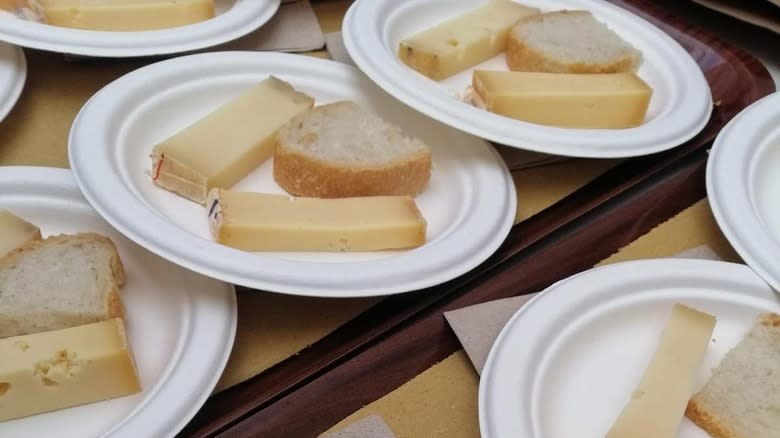
At first glance, Formai de Mut looks like any average cheese. It has a thin rind and a pale yellow paste, the body of the cheese under the rind. The rind can range in color from light yellow to gray, and the color of the rind is determined by the amount of time the cheese is ripened. It has a smooth, solid texture and an aroma filled with hints of vanilla, hay, and butter.
A rich, charming history makes Formai de Mut an interesting cheese, but it's the taste that creates lifelong fans. According to Cologni, the cheese is "very much appreciated by the locals to be simply eaten alone," without competing flavors to mask its distinct flavors.
The longer it's aged, the more complex flavors are able to develop. When aged for at least six months, Formai de Mut is a versatile, aromatic cheese with a savory flavor and subtle heat. The texture also undergoes a change when the cheese is aged for a longer period of time. The cheese loses its smoothness as it ages, becoming firmer. Though it's "not crumbly when it is fresh or medium seasoned," Formai de Mut becomes so firm "it could also be grated after long seasoning when the texture becomes one of a hard cheese," says Cologni.
How To Serve Formai De Mut
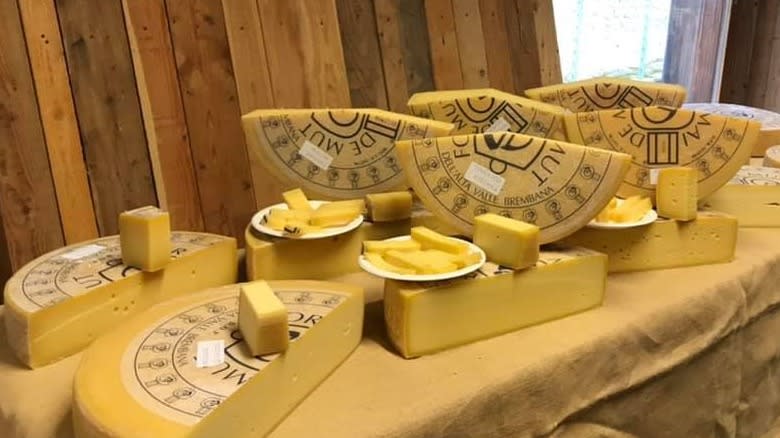
Serving cheese properly can be tricky. Should it be served chilled or at room temperature? Paired with big, bold red wines, delicate whites, or crisp, clean, sparkling wines? Which accompaniments will best highlight the cheese's natural flavors? Formai de Mut can be a challenge because the cheese's flavor can vary depending on the variety.
When the cheese is fresh, its mild flavor pairs best with white wine. Valcalepio wines, made in the same Lombardy region as Formai de Mut, work well with this cheese: A Valcalepio white for the unaged version and a red for the aged version.
When Formai de Mut is aged even for a short time, its flavor profile opens up more options for serving it. After aging for several weeks, the cheese's stronger flavor is enhanced by serving it with fresh fruit like pears. The passe crassane pear, a French pear known for its aromatic, floral notes, is the perfect match for Formai de Mut, along with rye bread and spicy pumpkin jam.
The aged Formai de Mut, with its slightly more intense taste, is bold enough to enjoy with red wine. Robust reds like those from areas close to the Brembana Valley, like barolo, which is known for its spicy, berry-influenced palate, are a delicious accompaniment to Formai de Mut.
Where To Buy Formai De Mut
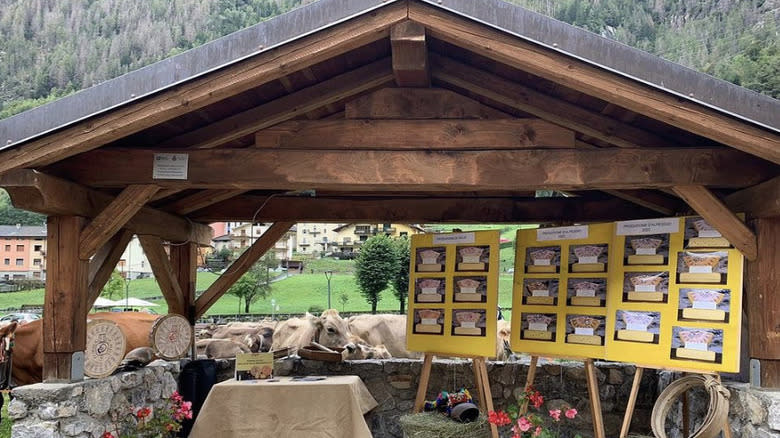
Formai de Mut can be a tricky cheese to find in the United States. It's not as widely distributed as more popular Italian cheeses like mozzarella and Asiago. It can also be challenging to find in Italy as there are never more than 1500 rounds of the cheese produced each year. The rounds weigh anywhere from 17 to 26 pounds. This is not just an arbitrary number. Italian law has very strict rules in place that determine how and where Formai de Mut can be produced, which limits its production. Thankfully, there are a few online options available.
OnlyItalianProducts.us carries Formai de Mut in wedges as small as 500 grams, just over one pound, and as large as 22 pounds. IGourmetUSA.com offers Formai de Mut, as well. Their wedges are hand-cut and hand-wrapped from 16-pound rounds.
The rare nature of this cheese is reflected in its price. The small wedge from OnlyItalianProducts.us, weighing slightly more than one pound, carries a hefty price of about $16. The 22-lb wedge will cost you more than $200, at the time of publication.
Nutritional Info
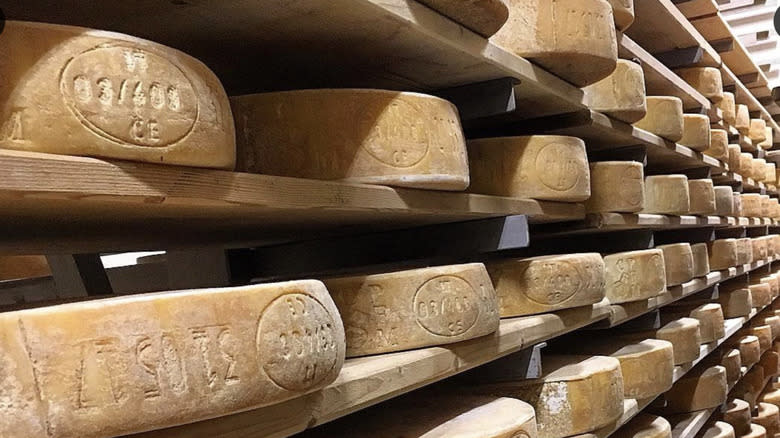
While cheese is typically not billed as a health food, it does have some nutritional benefits in addition to its fantastic taste. Many cheeses, including Formai de Mut, are good sources of calcium and protein. Cheese made from grass-fed cows can come with additional health benefits, like increased Omega-3 and Omega-6 fatty acids, which are vital tools in maintaining a healthy heart. There is some evidence that cheese is good for your heart.
Formai de Mut is made with raw milk, which gives it an increased milk fat content. Fat is often considered a negative factor in a diet, but Today's Dietician reports that the fats present in dairy products can help keep blood pressure low and reduce the risk of diabetes.
One 3.5 ounce serving of Formai de Mut contains 400 calories, 34 grams of fat, and 24 grams of protein. It also contains 875 miligrams of calcium and 684 miligram phosphorus, all of which are recommended for better health.
How To Store Formai De Mut

Even though most cheese is sold wrapped in plastic, plastic wrap is not the best way to preserve your cheese. Wrapping cheese tightly in plastic wrap might seem like a good idea, but the wrap can actually suffocate the cheese. Though you may not think of it this way, cheese is an actual living thing that needs some air to survive. So resist the temptation of storing your Formai de Mut in a plastic wrap blanket or a resealable plastic bag.
"In the past, they (Formai de Mut) were stored in the old stone cellars, sometimes in grottoes, too," said Cologni. Today, Formai de Mut is stored in cellars "where the temperature and humidity are controlled."
For best results, store Formai de Mut in the refrigerator. Instead of sealing it in plastic, consider wrapping it in cheese paper. Cheese paper is coated with wax, which simultaneously protects the cheese and allows it to breathe. If you don't have cheese paper on hand, don't fret. You can substitute wax paper or parchment paper instead.
How To Cook With Formai De Mut
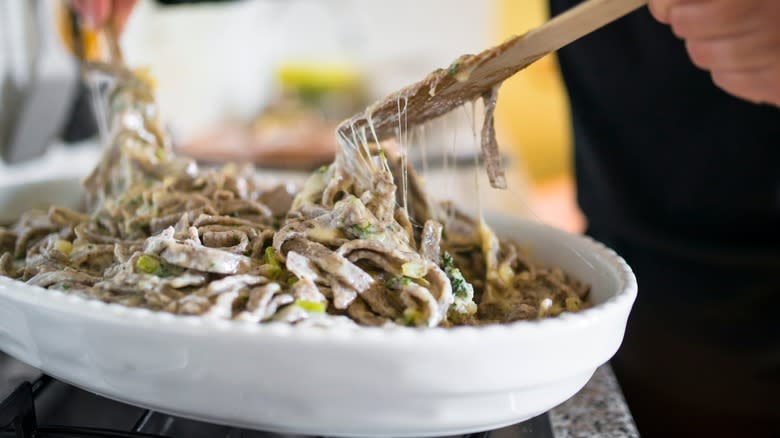
Formai de Mut is a versatile cheese. It's tasty enough to take center stage on a cheese board and also an excellent cheese to cook with. Formai du Mut is also used to prepare the traditional polenta taragna, one of the region's trademark dishes. The addition of an Alpine cheese, like Formai de Mut, at the end of cooking, transforms regular polenta into polenta taragna.
Pizzoccheri is another traditional Italian dish perfect for Formai de Mut. It's made with buckwheat noodles, potatoes, cabbage, and chunks of local cheese. The potatoes and cabbage are boiled in the same pot as the pasta. When the pasta and veggies are cooked, they're drained and then topped with the cheese. A sauce made of melted butter, sauteed garlic, and sage is poured over the pasta to melt the cheese.
Formai co' la bira di Valtorta is another way local Italians use Formai de Mut. For this recipe, a large slice of cheese is "immersed in the batter made with beer and white flour and fried in a very warm pan," Cologni says. The result is a soft, creamy center with a crispy crust.
What Sets Formai De Mut Apart From Other Italian Cheeses?
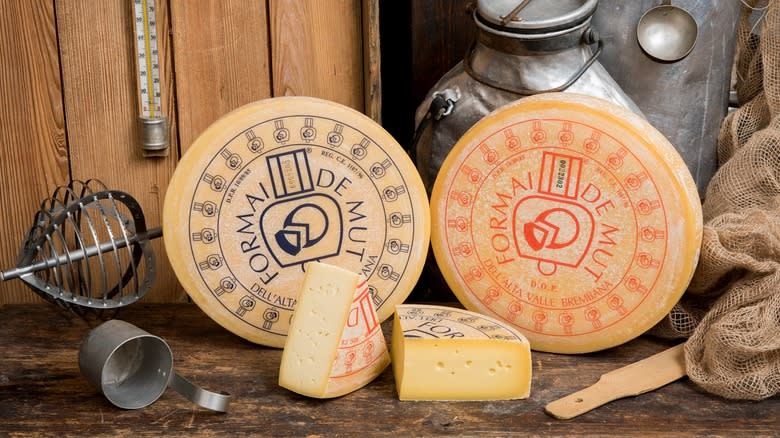
There are numerous characteristics that make Formai de Mut an extraordinary cheese — the way it's produced, the charming locations where the cows graze, and the variations in flavor based on the season it's made in. There's another distinction that makes Formai de Mut unique. This cheese has a protected status.
In Italy, a few cheeses have been awarded the D.O.P., Denominazione de Origine Protetta, or a Protected Designation of Origin. The Italian Ministry of Agricultural, Food, and Forestry Policies restricts the production of these products to a specific location and specific production process.
"This cheese has become first a D.O.C in 1985, and a D.O.P. cheese in 1996," said Cologni. "The livestock breeding, the production of milk, its processing, and the cheese seasoning must take place in the territories of the villages located in Alto Brembo and not elsewhere."
D.O.P. cheeses must also adhere to storing and aging requirements that determine how and for how long they are aged. This important designation helps preserve traditional cheeses and the cheesemaking techniques that produce them. These distinctions make the D.O.P. designation a coveted honor, as it indicates the cheese has been made using the highest-quality ingredients and processing.
Read the original article on Tasting Table.

